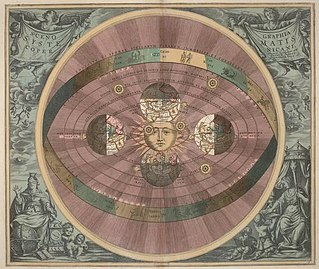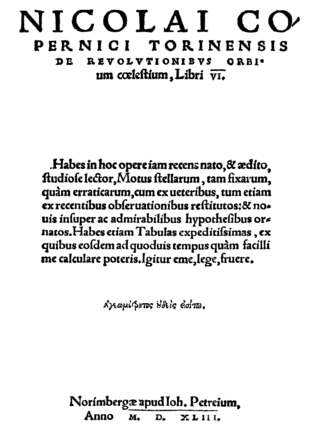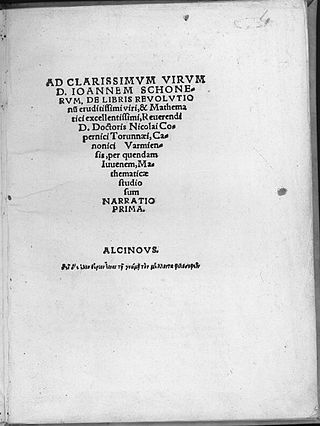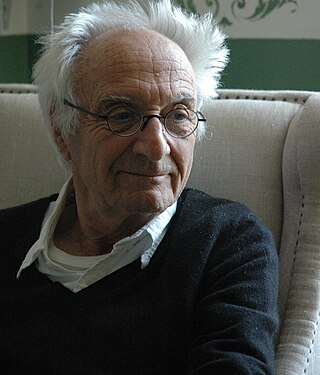Related Research Articles
Georg Joachim de Porris, also known as Rheticus, was a mathematician, astronomer, cartographer, navigational-instrument maker, medical practitioner, and teacher. He is perhaps best known for his trigonometric tables and as Nicolaus Copernicus's sole pupil. He facilitated the publication of his master's De revolutionibus orbium coelestium.
Domenico Maria Novara (1454–1504) was an Italian scientist.
This article contains information about the literary events and publications of 1543.

Heliocentrism is a superseded astronomical model in which the Earth and planets revolve around the Sun at the center of the universe. Historically, heliocentrism was opposed to geocentrism, which placed the Earth at the center. The notion that the Earth revolves around the Sun had been proposed as early as the third century BC by Aristarchus of Samos, who had been influenced by a concept presented by Philolaus of Croton. In the 5th century BC the Greek Philosophers Philolaus and Hicetas had the thought on different occasions that the Earth was spherical and revolving around a "mystical" central fire, and that this fire regulated the universe. In medieval Europe, however, Aristarchus' heliocentrism attracted little attention—possibly because of the loss of scientific works of the Hellenistic period.

Nicolaus Copernicus was a Renaissance polymath, active as a mathematician, astronomer, and Catholic canon, who formulated a model of the universe that placed the Sun rather than Earth at its center. In all likelihood, Copernicus developed his model independently of Aristarchus of Samos, an ancient Greek astronomer who had formulated such a model some eighteen centuries earlier.
Owen Jay Gingerich was an American astronomer who had been professor emeritus of astronomy and of the history of science at Harvard University and a senior astronomer emeritus at the Smithsonian Astrophysical Observatory. In addition to his research and teaching, he had written many books on the history of astronomy.

De revolutionibus orbium coelestium is the seminal work on the heliocentric theory of the astronomer Nicolaus Copernicus (1473–1543) of the Polish Renaissance. The book, first printed in 1543 in Nuremberg, Holy Roman Empire, offered an alternative model of the universe to Ptolemy's geocentric system, which had been widely accepted since ancient times.
The year 1543 in science and technology includes the 1543 Nicolaus Copernicus publication De revolutionibus orbium coelestium often cited as the beginning of the Scientific Revolution, and also includes many other events, some of which are listed here.

The Copernican Revolution was the paradigm shift from the Ptolemaic model of the heavens, which described the cosmos as having Earth stationary at the center of the universe, to the heliocentric model with the Sun at the center of the Solar System. This revolution consisted of two phases; the first being extremely mathematical in nature and the second phase starting in 1610 with the publication of a pamphlet by Galileo. Beginning with the 1543 publication of Nicolaus Copernicus’s De revolutionibus orbium coelestium, contributions to the “revolution” continued until finally ending with Isaac Newton’s work over a century later.
Trepidation, in now-obsolete medieval theories of astronomy, refers to hypothetical oscillation in the precession of the equinoxes. The theory was popular from the 9th to the 16th centuries.

The Commentariolus is Nicolaus Copernicus's brief outline of an early version of his revolutionary heliocentric theory of the universe. After further long development of his theory, Copernicus published the mature version in 1543 in his landmark work, De revolutionibus orbium coelestium.

De libris revolutionum Copernici narratio prima, usually referred to as Narratio Prima, is an abstract of Nicolaus Copernicus' heliocentric theory, written by Georg Joachim Rheticus in 1540. It is an introduction to Copernicus's major work, De revolutionibus orbium coelestium, published in 1543, largely due to Rheticus's instigation. Narratio Prima is the first printed publication of Copernicus's theory.

Copernican heliocentrism is the astronomical model developed by Nicolaus Copernicus and published in 1543. This model positioned the Sun at the center of the Universe, motionless, with Earth and the other planets orbiting around it in circular paths, modified by epicycles, and at uniform speeds. The Copernican model displaced the geocentric model of Ptolemy that had prevailed for centuries, which had placed Earth at the center of the Universe.

The Prutenic Tables, were an ephemeris by the astronomer Erasmus Reinhold published in 1551. They are sometimes called the Prussian Tables after Albert I, Duke of Prussia, who supported Reinhold and financed the printing. Reinhold calculated this new set of astronomical tables based on Nicolaus Copernicus' De revolutionibus orbium coelestium, the epochal exposition of Copernican heliocentrism published in 1543. Throughout his explanatory canons, Reinhold used as his paradigm the position of Saturn at the birth of the Duke, on 17 May 1490. With these tables, Reinhold intended to replace the Alfonsine Tables; he added redundant tables to his new tables so that compilers of almanacs familiar with the older Alfonsine Tables could perform all the steps in an analogous manner.

Jakob Christmann was a German Orientalist who also studied problems of astronomy.
The Nicolaus-Copernicus-Gesamtausgabe is a comprehensive, commented collection of works by, about, and related to Nicolaus Copernicus. The Gesamtausgabe includes Copernicus's surviving manuscripts and notes, his published writings, other authors' commentary about Copernicus and his works, a bibliography, and a biography.

The Nicolaus Copernicus Monument in Warsaw is one of the Polish capital's notable landmarks. It stands before the Staszic Palace, the seat of the Polish Academy of Sciences on Krakowskie Przedmieście. Designed by Bertel Thorvaldsen in 1822, it was completed in 1830. Thorvaldsen's original plaster model from 1822 and a smaller study from 1821 are both held by the Thorvaldsen Museum in Copenhagen.
The year 1512 in science and technology included a number of events, some of which are listed here.

Jean-Pierre Verdet is a French astronomer, historian of astronomy and mathematician.

The autograph of Nicolaus Copernicus' De revolutionibus is a manuscript of six books of De revolutionibus orbium coelestium (1543) by Nicolaus Copernicus written between 1520 and 1541. Since 1956, it is kept in the Jagiellonian Library in Kraków.
References
- ↑ Gingerich, Owen (2004). The Book Nobody Read: Chasing the Revolutions of Nicolaus Copernicus . New York: Walker. ISBN 0-8027-1415-3.
- ↑ Koyré, Alexandre (1973). The Astronomical Revolution: Copernicus – Kepler – Borelli. Ithaca, New York: Cornell University Press. ISBN 0-8014-0504-1.